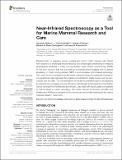Files in this item
Near-infrared spectroscopy as a tool for marine mammal research and care
Item metadata
| dc.contributor.author | Ruesch, Alexander | |
| dc.contributor.author | McKnight, J. Chris | |
| dc.contributor.author | Fahlman, Andreas | |
| dc.contributor.author | Shinn-Cunningham, Barbara G. | |
| dc.contributor.author | Kainerstorfer, Jana M. | |
| dc.date.accessioned | 2022-01-18T16:30:18Z | |
| dc.date.available | 2022-01-18T16:30:18Z | |
| dc.date.issued | 2022-01-17 | |
| dc.identifier | 277506261 | |
| dc.identifier | 3f7e8258-11e3-42c5-9bc2-1bd411fc7bb1 | |
| dc.identifier | 85123790776 | |
| dc.identifier | 000752758500001 | |
| dc.identifier.citation | Ruesch , A , McKnight , J C , Fahlman , A , Shinn-Cunningham , B G & Kainerstorfer , J M 2022 , ' Near-infrared spectroscopy as a tool for marine mammal research and care ' , Frontiers in Physiology , vol. 12 , 816701 . https://doi.org/10.3389/fphys.2021.816701 | en |
| dc.identifier.issn | 1664-042X | |
| dc.identifier.other | Bibtex: 10.3389/fphys.2021.816701 | |
| dc.identifier.other | ORCID: /0000-0002-3872-4886/work/106838198 | |
| dc.identifier.uri | https://hdl.handle.net/10023/24699 | |
| dc.description | This project was partially funded by the Department for Business, Energy and Industrial Strategy Offshore Energy Strategic Environmental Assessment Programme. Supplementary funding supporting JM was provided by the US Office of Naval Research (ONR) grant nos. N00014-18-1-2062 and N00014-20-1-2709. Supplementary funding supporting AF and JM was provided by the US Office of Naval Research (ONR) grant no. N00014-19-1-2560. Supplementary funding supporting BS-C, JK, and AR was provided by the US Office of Naval Research (ONR) grant no. N00014-19-1-1223. | en |
| dc.description.abstract | Developments in wearable human medical and sports health trackers has offered new solutions to challenges encountered by eco-physiologists attempting to measure physiological attributes in freely moving animals. Near-infrared spectroscopy (NIRS) is one such solution that has potential as a powerful physio-logging tool to assess physiology in freely moving animals. NIRS is a non-invasive optics-based technology, that uses non-ionizing radiation to illuminate biological tissue and measures changes in oxygenated and deoxygenated hemoglobin concentrations inside tissues such as skin, muscle, and the brain. The overall footprint of the device is small enough to be deployed in wearable physio-logging devices. We show that changes in hemoglobin concentration can be recorded from bottlenose dolphins and gray seals with signal quality comparable to that achieved in human recordings. We further discuss functionality, benefits, and limitations of NIRS as a standard tool for animal care and wildlife tracking for the marine mammal research community. | |
| dc.format.extent | 8 | |
| dc.format.extent | 3492878 | |
| dc.language.iso | eng | |
| dc.relation.ispartof | Frontiers in Physiology | en |
| dc.subject | Near-infrared spectroscopy | en |
| dc.subject | Marine mammals | en |
| dc.subject | Physio-logging | en |
| dc.subject | Wearable | en |
| dc.subject | Vital signs | en |
| dc.subject | Driving physiology | en |
| dc.subject | GC Oceanography | en |
| dc.subject | QD Chemistry | en |
| dc.subject | QP Physiology | en |
| dc.subject | DAS | en |
| dc.subject | SDG 3 - Good Health and Well-being | en |
| dc.subject | SDG 13 - Climate Action | en |
| dc.subject | SDG 14 - Life Below Water | en |
| dc.subject | MCC | en |
| dc.subject.lcc | GC | en |
| dc.subject.lcc | QD | en |
| dc.subject.lcc | QP | en |
| dc.title | Near-infrared spectroscopy as a tool for marine mammal research and care | en |
| dc.type | Journal article | en |
| dc.contributor.institution | University of St Andrews. School of Biology | en |
| dc.contributor.institution | University of St Andrews. Sea Mammal Research Unit | en |
| dc.identifier.doi | 10.3389/fphys.2021.816701 | |
| dc.description.status | Peer reviewed | en |
This item appears in the following Collection(s)
Items in the St Andrews Research Repository are protected by copyright, with all rights reserved, unless otherwise indicated.

